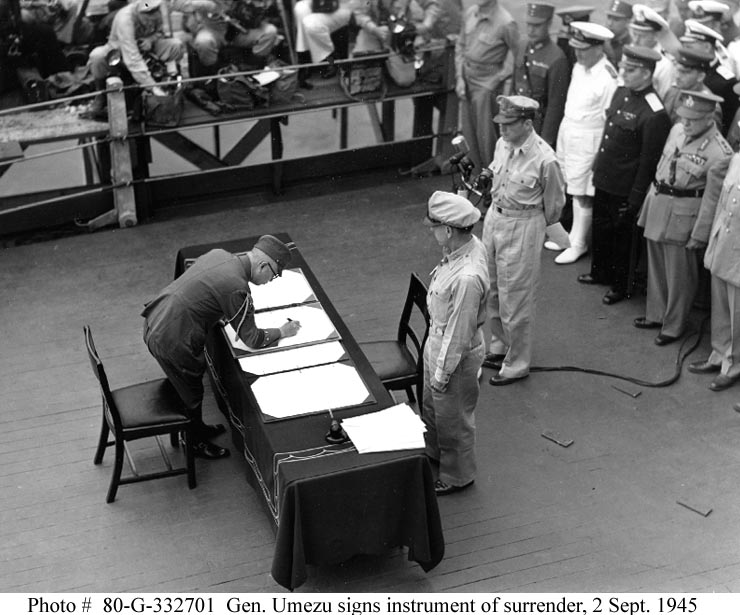
Gen Umezu signs the surrender instrument
aboard USS Missouri, September 2, 1945,
Tokyo Bay, Japan,
on the same day that Col. Tozuka signed his own surrender instrument at Cabatuan Airfield in Cabatuan, Iloilo, Panay Island, Philippines.
(U.S. Navy Photo)
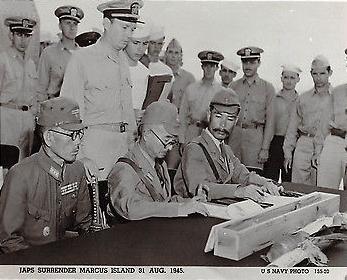
"Japs Surrender Marcus Island 31 Aug. 1945"
This signing happened two days before the one at Cabatuan Airfield, Panay Island, Philippines.
(U.S. Navy Photo)
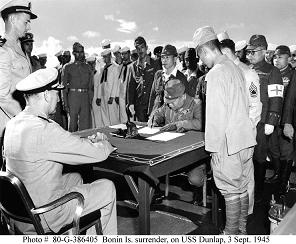
"Bonin Island Surrender, on USS Dunlap, 3 Sept. 1945."
This signing happened one day after Col. Tozuka signed his own at Cabatuan Airfield, Panay Island, Philippines.
(U.S. Navy Photo)
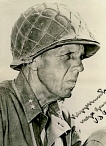
MGen. Brush
Major General Rapp Brush was the 40th Infantry Division commander until July 1945 when he was relieved by Brigadier General Myers.
The 40th Division was also transferred from the U.S. 8th Army to the U.S. 6th Army before the Japanese surrender signing ceremony at Cabatuan Airfield took place. Maj. Gen. Brush retired later that year, on December 31, 1945.
- o -
|
Lt. Col. Tozuka signs Surrender Instrument as Col. Stanton looks on
JAPANESE SURRENDER IN PANAY ISLAND, SEPT 2, 1945
CABATUAN AIRFIELD, BARRIO TIRING, CABATUAN, ILOILO
© Ronnie Miravite Casalmir (California, U.S.A.) / , 2015
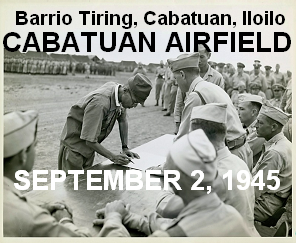
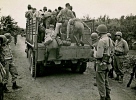
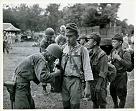
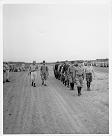
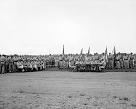
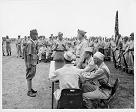
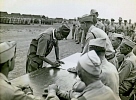
LCol. Ryoichi Tozuka signs the surrender instrument
as Col. Raymond G. Stanton looks on.
Cabatuan Airfield
Barrio Tiring, Cabatuan, Iloilo
Panay Island, Philippines, September 2, 1945
|
|
August 10, 2015
2015 marks the 70th anniversary of the end of World War II. Events like the signing of the surrender instrument aboard the USS Missouri in Tokyo Bay on September 2, 1945 are being commemorated to remind us of the end of years of suffering and horror on all sides.
In Panay Island, the end of World War II came with the signing by Lt. Col. Ryoichi Tozuka of the surrender instrument in Cabatuan Airfield, the same day as in Tokyo Bay, September 2, 1945.
Lt. Col. Tozuka commanded the 170th Independent Infantry Battalion, formerly the 37th Independent Infantry Battalion. The 37th or Tozuka Unit was reorganized in December 1943 after the Japanese punitive drive in Panay and became the 170th.
Protocol dictates that the surrender of a Colonel be received by another Colonel, and so, Col. Raymond G. Stanton, the commanding officer of the 160th Infantry Regiment, was designated to receive, even though his superiors were also present.
Around noontime, all the Japanese officers were assembled by Lt. Col. Tozuka. They marched to the "stage" at a corner of Cabatuan Airfield. The surrender instrument was read by the Japanese-American translator.
Afterwards, Lt. Col. Tozuka signed as Col. Stanton looked on.
Among the Japanese officers who attended that day, one stood out from the rest later. His name was Lt. Toshimi Kumai. After the war, and after his incarceration in Japan, he came back to Iloilo to atone for what had transpired during the war. He published his memoir, from which we can glean his accounts of that fateful day.
"The next day, a little after noon, all officers were assembled to attend the surrender ceremony. As we made our way to the setting of the ritual, we saw US soldiers feverishly checking out the belongings of Japanese soldiers who descended from trucks. Every one of them had gotten rid of weapons and they were running around in confusion amidst the shouting of US soldiers. The elite troops of Panay already looked quite like POWs."
"The venue for the surrender ceremony was a corner of the airfield beside the camp, where hundreds of military vehicles were parked. A battalion of US troops and a company of intrepid-looking Filipino Army personnel were standing in rows. I carefully observed the behavior of the Filipino soldiers against whom we had fought. In following orders, no movement of theirs looked inferior to that of the American soldiers, making me think of the hard training they must have received."
"At the center was a stage where Colonel Stanton stood. Representing the Japanese Army, the Tozuka unit commander loudly read out the statement of surrender of the Japanese Army to the US Forces. As expected from the look of the setting, the ceremony ended rather simply."
At least 16 Japanese Imperial Army officers were assembled to attend the surrender signing ceremony.
Presumably present were Capt. Kaneyuki Koike (commanding the Kempei Tai unit on Panay Island), 1st. Lieut. Sadayoshi Ishikawa and 1st. Lieut. Horimoto. Capt. Koike along with Lieuts. Ishikawa and Kumai composed the "advance surrender party" that negotiated the manner of surrender a few days earlier, on August 28, 1945, with Sergeant Matsuzaki as interpreter. The NCO cadet platoon escorting them from Bocari to Daja Maasin was led by 1st Lieutenant Horimoto, with Private First Class Ueki as interpreter. The "advance surrender party" met with American representatives at Maasin plaza, and returned back to Bocari afterwards. As agreed upon, the Japanese forces then started to surrender on September 1, 1945, with the formal surrender signing ceremony by Lt. Col. Tozuka happening the following day on September 2, 1945 at Cabatuan Airfield.
1Lt Makoto Yoshioka,
2Lt Fukumori Okuda,
2Lt Mikio Kai,
Sgt Maj Takeji Wada,
Sgt Shichiro Inoue,
Pfc Akiro Sato,
Pfc Heiji Watanabe,
Private Second Class Chikaichi Ota, may also have been present at Cabatuan Airfield during the surrender signing ceremony. They were from the Japanese unit in San Jose, Antique, which joined up with Lt. Col. Tozuka in Bocari, Leon when the Japanese retreated to the mountains. They were later put on trial for the killing of American prisoners in March 1945 in San Jose.
About 1,200 Japanese soldiers from Bocari, Leon surrendered on September 1-2, 1945. They were then brought to Cabatuan Airfield where they were interned. (Another 500 Japanese soldiers from Mt. Singit, Lambunao surrendered on September 3-4, 1945, and were also brought to and interned at Cabatuan Airfield)
On the American side, the signing ceremony at Cabatuan Airfield was attended by the U.S. Army and U.S. Navy brass, led by Brigadier General Donald Myers, commanding the 40th Infantry Division, and Rear Admiral (the navy's equivalent of major general) Ralph O. Davis, commanding the 13th Amphibious Group. The Assistant Commander of the 40th Division was Brig. Gen. Robert O. Shoe.
Also present was Capt. Bob O. Mathews, the skipper of USS Estes, which was the flagship of the U.S. Navy's 13th Amphibious Group. The 13th Amphibious Group was tasked to transport the 40th Division from Iloilo to Korea for occupation.
The USS Estes arrived in Iloilo from Leyte on September 1, 1945, with Rear Admiral Davis and his staff on board. The following day, September 2, 1945, The ship sent a detail ashore to take part in the Japanese surrender ceremony. Norman Lindenberg was a member of that detail and had some documents and pictures taken that day. John J. DeBenedetto, also on USS Estes, had a similar photo collection. [Norman Lindenberg, John J. DeBenedetto/Thomas DeBenedetto, USS Estes Association]
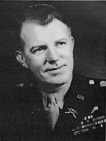
Col. Stanton
160th Inf Regiment
|
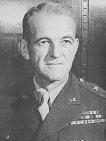
Brig. Gen. Myers
40th Inf Division
|
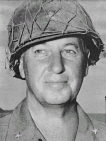
Brig. Gen. Shoe
40th Inf Division
|
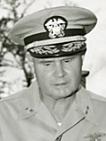
Rear Adm. Davis
13th Amphibious Group
|
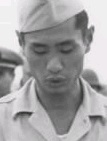
T-Sgt. Terno Odow
180th Language Det.
U.S. Army
|
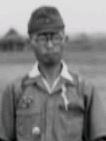
Lt. Col. Tozuka
Japanese Imperial Army
|
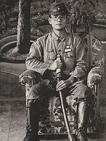
Lieut. Kumai
Japanese Imperial Army
|
|
Col. Raymond G. Stanton graduated in 1927 from the United States Military Academy (USMA), also known as West Point. He was a veteran of the Pacific Theater from New Guinea to the Philippines. His brother, Col. Walter C. Stanton, belonged to West Point Class 1926. His uncle, Col. Hubert G. Stanton, to West Point Class 1911. A fourth member of the family, his nephew Walter C. Stanton Jr., graduated from West Point in 1950.
It appears from the signing photo that Col. Stanton was wearing his West Point class ring while accepting the surrender in Cabatuan.
The American honor guard standing behind him came from the Intelligence and Reconnaissance Platoon commanded by then Lieutenant Herman E. Bulling.
One member of the honor guard was Pfc. Everett L. Farris. He saw action on Leyte and Mindanao. He wears the Combat Infantry badge, the Asiatic-Pacific ribbon with one campaign star and a Bronze Arrowhead, the Philippine liberation and Good Conduct ribbons.
Other members mentioned were Cpl Harvey H. Miller of Hagerstown Maryland, and Curt Ittner.
In an interview on June 27, 2003, done by Shaun Illingworth and Jared Kosch, with Mrs. Helen Bulling attending, and published by the Rutgers Oral History Archives, Herman E. Bulling states that:
"my I&R Platoon was the honor guard for the ceremony and, of course, the Colonel (Col. Stanton) was great on ceremony. I mean, he had long tables set up with the staff officers sitting there, and, in fact, I have, someplace, got pictures of that, too. That was one of the worst impositions I ever made on my father. [I] got those pictures, I sent them home and I said, "Dad, I need forty copies of these," and, at that point, my father, somehow or other, got forty copies made and sent them back to me and every member of my platoon had copies of the surrender ceremonies; Colonel Stanton, accepting the surrender."
Herman E. Bulling further adds about the Japanese forces:
"I don't know, he wasn't that much of a big shot, but he was in charge of whoever was up in the hills. They were in terrible shape. They were physically exhausted. They'd probably been in the hills for two or three years (actually 6 months) and they had come down out of the hills only to be put into a stockade, but they were better off there than they had been up in the hills, because the farmers had said that there were raids on their fields, but they couldn't have been getting enough food."
Another officer who was reportedly involved in accepting the surrender was Lt. Col. James E. Marr, a battalion commander of the 40th Division.
The Japanese-American translator (standing at the end of the table) during the surrender signing ceremony at Cabatuan Airfield was T-Sgt. Terno Odow of the 180th Language Detachment. He had previously drafted four leaflets, in English and Japanese, 40,000 of which were dropped on two Philippine islands. The leaflets were directly responsible for the surrender of 5,000 Japanese troops. He then drew the assignment of questioning a large portion of about 1,700 Japanese soldiers who surrendered in Panay.
Sgt. Odow was an intelligence specialist, interpreter and interrogator. He speaks fluent Japanese, having spent two years at Keio University, Tokyo, before the outbreak of the war. He was a veteran of campaigns on Guadalcanal, New Britain, Luzon, Panay and Negros.
Meanwhile, the Filipino infantry company present during the surrender signing ceremony was organized and commanded by Capt. Eliseo D. Rio. Tall men were selected from among the ranks of the 1st Battalion 52nd Infantry Regiment and were given new uniforms and equipment in time for the ceremony.
Lieut. Kumai had this to say:
"a company of intrepid-looking Filipino Army personnel were standing in rows. I carefully observed the behavior of the Filipino soldiers against whom we had fought. In following orders, no movement of theirs looked inferior to that of the American soldiers, making me think of the hard training they must have received."
Frank Patrick, a projectionist in the U.S. Army along with his duties as a radio operator, was one of those who had taken photos that day of the Japanese surrender signing ceremony. All indications are that he was on the front row.
[Gail Rooks, Walter Geiger; Features, The Herald Gazette, Barnesville, GA, December 7, 2016]
Lieut. Kumai's book, "The Blood and Mud in the Philippines," was based on the original publication in Japanese, "Firipin no Chi to Doro: Taiheiyosen Saiaku no Gerirasen" (Tokyo: Jiji Press, 1977). It was translated by Yukako Ibuki, and edited by Ma. Luisa E. Mabunay and Ricardo T. Jose.
In his book, Lieut. Kumai referred to the airfield several times as 'Cabatuan Airfield,' in addition to describing its location accurately as being in Cabatuan, Iloilo.
The airfield was called Cabatuan Airfield by the Japanese Imperial Army after the Municipality of Cabatuan, Iloilo where it was located; Tiring Landing Field by the Free Panay and Romblon Government of Governor Thomas Confesor and the Panay guerillas of Col. Macario Peralta, after Barrio Tiring, Cabatuan, where it was specifically located; Tiring Airfield and Tiring Field by the Americans, after Barrio Tiring, Cabatuan; and erroneously as Santa Barbara Airfield or Santa Barbara Airstrip by the Americans, erroneous since the airfield was not located in the neighboring town.
The Japanese forces operated Cabatuan Airfield the longest, from the time they arrived in Panay in 1942, until they retreated to the mountains in 1945.
Chapters of Blood and Mud in the Philippines mentioning 'Cabatuan Airfield':
Chapter 7,
Chapter 8,
Chapter 10,
Chapter 11
CABATUAN AIRPORT
Cabatuan.com
(Bookmark this page for future reference)
|
|



